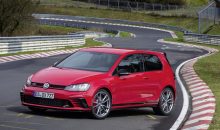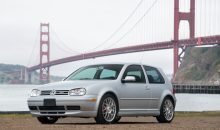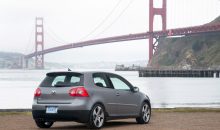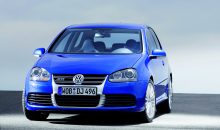
The most powerful Golf GTI ever breaks the lap record for front-wheel-drive cars on the Nordschleife, with a time of 07:49:21
Wolfsburg/Reifnitz, May 2016. The Golf GTI Clubsport S is the most powerful ever version of the Golf GTI and was built to celebrate 40 years of the iconic hot hatchback. With German racing driver Benny Leuchter (28) at the wheel, the car has just smashed the existing lap record for front-wheel-drive production cars on the Nürburgring Nordschleife, with a time of 7 minutes, 49.21 seconds.
This exclusive new vehicle, based on the Golf GTI Clubsport, makes its world premiere at the GTI event at Lake Wörthersee (4-7 May). The hard performance numbers of this new GTI are truly impressive: a power output of 228 kW/310 PS; 280 pound-feet of torque between 1,700 and 5.300 rpm; 0 to 62 mph acceleration in 5.8 seconds; a top speed of 162 mph; and an unladen weight (including the driver and luggage) that has been reduced to 2,998 pounds. But the raw figures don’t tell the whole story, as the record lap time around the Nordschleife demonstrates how fast this car actually is.
The Golf GTI Clubsport S has an exclusive setting for the most demanding racetrack in the world, which can be accessed using the driving profile selector. This is possible because the car is fitted as standard with the individually configurable Dynamic Chassis Control (DCC) and a driving profile selector. In the ‘Individual’ driving profile, the engineers have developed a setting that is fine-tuned to suit the unique conditions of the Nürburgring. Over and above that, the Comfort, Normal and Race settings are also available. The driver can still adjust the settings in the Individual profile, as usual, and can revert to the Nürburgring setting by resetting the Individual profile on the touchscreen menu. This unique configuration switches the Sound, Engine and Steering parameters in the Race profile as well as DCC to Comfort. However, in this instance an entirely different group of settings is hidden behind this option, instead of the normal Race and Comfort settings.
The production run will be limited to 400 cars worldwide, 100 of which will be delivered to customers in Germany. Colors will be limited to those of the original GTI: “Tornado Red”, “Pure White” and “Deep Black Pearl Effect”, with the roof painted black. The Clubsport S is based on the two-door model with a manual transmission, in order to keep the weight as low as possible.
The Clubsport S is a pure two-seater. Doing away with the rear seats, including the central armrest, for example, accounts for the most noticeable weight saving. A smaller battery, as well as doing without insulation, the variable-height trunk floor, the rear parcel shelf, and the floor mats pushed the weight down yet further. An aluminum subframe for the front suspension and aluminum brake covers also shed weight. On the other hand, 235/35 ZR Michelin tyres mounted on 19-inch “Pretoria” aluminium-alloy wheels, DCC, a strut brace, a partition net behind the seats and a carpet in the rear add some of that saving back, for a total weight reduction of approximately 66 pounds in comparison to a similarly equipped Golf GTI Clubsport. The unladen weight is 2833 pounds, resulting in a dynamic power-to-weight ratio of 9.14 pounds per horsepower. Less weight also means greater fuel efficiency, with an NEDC rating of 31.8 mpg (equivalent to 172 g/km CO2).
The development team exploited synergies between motorsport and production vehicles in enhancing the engine performance, as they could draw on their experience with the 243 kW/330 PS Golf GTI TCR—the new racing car for the TCR International Series. This also gave them the opportunity to boost the engine to 310 PS and 280 lb-ft. The engineers achieved this boost in performance with a modified engine control unit and a new exhaust system: an increased diameter of 2.56 inches instead of 2.16 in reduces the exhaust backpressure and increases the performance. A side effect of the modifications is that the exhaust system produces a wonderful and deliberate ‘backfire’ under braking! In the course of the modifications the engineers also integrated a new fuel pump with increased throughput. The engine of the front-wheel drive Golf GTI Clubsport S is technically based on the 1,984 cc TSI engine that also powers the other versions of the Golf GTI and the Golf R.
Exterior
Other changes for the most exclusive Golf GTI include the following: semi-slick Michelin Sport Cup 2 tires mounted on 19-inch “Pretoria” alloy wheels, tinted rear windows that absorb 65 percent of the light, “Clubsport S” type plates, Bi-Xenon headlights with cornering lights and LED daytime running lights. The brake system was also modified to withstand the high temperatures inflicted at a racetrack. The disc bells are made of aluminium and are connected to the steel discs by cast location pins, allowing them to expand radially when they heat up. An important factor for the car’s handling is that the unsprung mass of each wheel is 2.2 pounds lower thanks to the aluminum brake covers. To further improve the braking performance, the Golf GTI Clubsport S has special brake pads.
Interior
Each of the 400 Golf GTI Clubsport S cars made will have its production number (001/400 to 400/400) on the center console in the front. The driver and the front seat passenger sit in racing bucket seats that provide the necessary lateral support while flying around the Nordschleife. The car also features GTI insignia that’s featured in the “normal” Golf GTI Clubsport, including the iconic golf ball shifter knob with Alcantara trim, a red line in the safety belts, “Honeycomb 40” design decals on the dashboard and doors, and elegant Piano Black accents. The extremely grippy Alcantara-trimmed sport steering wheel, which has a chrome GTI emblem, red stitching and the 12-o’clock position marked out, was designed to be ergonomically perfect for the track.
Genesis
The idea for the Golf GTI Clubsport S originated when the team responsible for the “normal” GTI at Volkswagen tested the final version of the current Golf GTI Performance Pack on the racetrack. “It was obvious to all of us that this GTI had immense potential,” recalls Karsten Schebsdat, Head of Chassis Tuning, “so we decided to get the most performance possible out of this car. A small team went through the entire process, from bottom to top, pretty much like it was back when the first Golf GTI came into being.” In addition to the weight reduction and the improvement in performance, two other factors are of fundamental importance when it comes to designing a really fast car: optimal aerodynamics and an outstanding chassis.
When it comes to aerodynamics, Volkswagen was able to draw on the modifications already implemented in the Golf GTI Clubsport. Both the “Clubsport” and the “Clubsport S” have completely new front bumpers that improve engine induction, front end aero, and downforce. At the rear, the roof-edge spoiler that was perfected in the wind tunnel and is significantly larger on the Clubsport versions results in significant amounts of additional rear downforce. In conjunction with a black rear diffuser, this two-part rear wing generates more downforce on the rear axle than on the front axle. In the case of the Golf GTI Clubsport S, this means that the understeer that is typical of front-wheel-drive cars is practically eliminated.
The new Golf GTI Clubsport S also has a special sport chassis. Karsten Schebsdat explains: “To neutralize the understeer and at the same time boost grip levels, we counteracted understeer on the front axle and specially designed the hub carriers,” resulting in higher camber angles. The negative camber increases the potential for directional control, thus optimizing the grip on the front axle. The Clubsport S is characterised by similarly good balance to the “normal” Clubsport, even at higher levels of lateral acceleration, allowing even higher cornering speeds. Braking performance was also perfected, in particular to prevent the rear end from breaking away: combined with the aerodynamic measures, this allows the driver to brake into bends in a controlled way.
Even at full acceleration the car has even better traction due to the modified chassis tuning and the tires. Volkswagen was also able to fine-tune the ESC software on this basis: even though the traction control intervenes later in the Golf GTI Clubsport S and the torque is reduced less, “wheel hop” from the front wheels, typical of powerful front-wheel drive cars at maximum acceleration, is practically eliminated. The extra acceleration is also handled by stiffer engine mounts, a new coupling rod between the transmission and front axle, and a reinforced transmission. Other important elements include the XDS+ system and the electronically controlled, torque-sensing limited slip differential.
As is the case for the other GTI models, Volkswagen also offers the ‘ESC Sport’ function for very experienced drivers. The system is activated by a two-stage switch on the center console. When the driver presses this switch briefly, Electronic Stability Control (ESC) switches to the ‘ESC Sport’ mode. In very fast driving with lots of bends—such as on the Nordschleife—ESC responds later and thereby gives even more agile handling. If the driver pushes the switch for more than three seconds, the ESC system is completely deactivated. As an alternative to the push-button switch on the centre console, the ESC can also be activated or deactivated in the settings on the car menu.
Chassis
The new Golf GTI Clubsport S has a special sport chassis. The chassis experts also reconfigured both of the axles of the Golf GTI Clubsport S. Take, for example, the rear axle: the modular performance axle has been given extra potential for directional control in order to achieve higher lateral accelerations. But without altering the McPherson front axle this would result in greater understeer. As Karsten Schebsdat, the chassis expert, explains: “To neutralise the understeer and at the same time boost grip levels, we counteracted understeer on the front axle and specially designed the hub carriers”, resulting in higher camber angles. The negative camber increases the potential for directional control, thus optimising the grip on the front axle. The Clubsport S is characterised by similarly good balance to the “normal” Clubsport, even at higher levels of lateral acceleration, allowing even higher cornering speeds. Braking performance was also perfected, in particular to prevent the rear-end from breaking away, especially when braking into very fast corners. Combined with the aerodynamics measures, this results in the driver being able to brake into bends with the Golf GTI Clubsport S in a controlled way, without losing driving stability, resulting in extremely good driveability up to the limits and a lap time around the Nordschleife of just 07:49:21.
Traction control
Even at full acceleration the car has yet better traction due to the modified chassis tuning and the semi-slicks. Volkswagen was also able to fine-tune the ESC software on this basis: Even though the traction control intervenes later in the Golf GTI Clubsport S and the torque is reduced less, when it does intervene, the “wheel hop” of the front wheels, typical of powerful front-wheel drive cars at maximum acceleration, is practically eliminated. This noticeable effect is similar to that of Launch Control in automatic cars. The acceleration boost is perfected by harder engine mounts, a new pendulum support (a coupling rod between the transmission and front axle) as well as a reinforced transmission. Other important elements include the XDS+ vehicle dynamics function and the front differential lock, which also comes as standard.
- Front differential lock. Compared to purely mechanical locks, the front differential lock integrated in the Golf GTI Clubsport and the Golf GTI Clubsport S has a variable degree of locking and comprehensively integrates with the functions of ESC, EDS and XDS+. This makes it possible to completely avoid negative effects on steering precision that would otherwise occur with mechanical locks.
- ESC Sport. As is the case for the other GTI versions, Volkswagen also offers the ‘ESC Sport’ function for very experienced drivers. In the Golf GTI Clubsport S. The system is activated by a two-stage switch on the centre console. When the driver presses this switch briefly, Electronic Stability Control (ESC) switches to the ‘ESC Sport’ mode. In very fast driving with lots of bends – such as on the Nordschleife – ESC responds later and thereby enables even more agile handling characteristics. If the driver pushes the switch for more than three seconds, the ESC system is completely deactivated. Now the GTI can be driven to the limit at the driver’s own discretion, without any regulating interventions. As an alternative to operation via the push-button switch on the centre console, the ESC can also be activated or deactivated in the settings on the car menu.
Aerodynamics
When it comes to aerodynamics and the associated downforce values, Volkswagen was able to draw on the modifications already implemented in the Golf GTI Clubsport. Both versions – the “Clubsport” and the “Clubsport S” – are characterised by completely new front bumpers. The new design offers improvements in air supply to the engine, aerodynamics and downforce at the front. At the rear, the roof-edge spoiler that was aerodynamically perfected in the wind tunnel, and is significantly larger on the Clubsport versions than its counterpart on the Golf GTI and Golf GTI Performance, results in significantly optimised aerodynamics. There is a narrow air gap between the roof area, that is completely black, and the wing-like spoiler placed above it. The two-part roof edge spoiler extends upward above the roof line. At the sides, the spoiler merges into the black flaps on the boot lid. Multi-part spoilers of this type are complex components that perfectly fulfil the aerodynamic tasks assigned to them: to significantly increase downforce on the rear axle. A black rear diffuser is also included in this design and aerodynamics concept. To fine-tune the Clubsport versions to give them extra stability, the aerodynamics measures generate more downforce on the rear axle than on the front axle. This boost in driving stability, especially on the rear axle, is used to fine-tune the chassis to make for a smoother ride. In the case of the Golf GTI Clubsport S this means that the understeer so typical of front-wheel-drive cars is practically eliminated.
Limited to a run of 400
The production run of 400 cars is the total worldwide figure, 100 of which will be delivered to customers in Germany. The colours of the limited edition stick to those of the original GTI: “Tornado Red”, “Pure White” and “Deep Black Pearl Effect”, and the roof of the red or white GTI Clubsport S is also painted black. No matter where in the world this car makes an appearance, it will always be a two-door manual transmission to keep its weight down. In comparison to the two-door Golf GTI Clubsport with a manual gearbox, the net weight of the “S” was reduced significantly, to achieve a power-to-weight ratio of 4.15 kg/PS.The Golf GTI Clubsport S, which produces 380 Nm at between 1,700 and 5,300 rpm is a two-seater. Doing away with the rear seats, including the central armrest, for example, accounts for the most noticeable weight saving. A smaller battery, as well as doing without details such as the insulating material, the variable luggage compartment floor, the rear parcel shelf, the floor mats and the bonnet damping pushed the weight down yet further. An aluminium subframe on the front axle and aluminium brake covers resulted in further weight savings. The 235/35 ZR Michelin tyres mounted on 19-inch “Pretoria” alloy wheels, which are so important for performance, the equally essential DCC, as well as a strut brace, a partition net behind the seats and a carpet in the rear, on the other hand, added weight, leaving a total weight reduction of approx. 30 kg, in comparison to a similarly equipped Golf GTI Clubsport, and thus a low DIN unladen weight of just 1,285 kg (EU unladen weight, incl. driver and luggage: 1,360 kg). At 310 PS this thus results in a dynamic power-to-weight ratio of 4.15 kg/PS. Less weight also means greater efficiency: 7.4 l/100 km (equating to 172 g/km CO2).
Engine specifications
The development team exploited synergies between motorsport and production vehicles in enhancing the engine performance, as they could draw on their experience with the 243 kW/330 PS/410 Nm Golf GTI TCR – the new racing car for the TCR International Series. This also gave them the opportunity to boost the engine to a permanent 310 PS and 380 Nm and at the same time include the race set-up of the Golf GTI TCR from the Saloon Car Championship. In detail, the engineers achieved this boost in performance by adaptation of the engine control unit and the use of a new exhaust system, with a diameter ahead of the exhaust tailpipes of 65 instead of 55 mm, thus reducing the exhaust backpressure and increasing the performance. A side effect of the modifications was that the exhaust system produces a wonderful and deliberate ‘backfire’ when braking! This is particularly true for the Race driving profile (along with extra features such as higher engine speed etc.), in which the Golf GTI Clubsport S is tuned to have maximum performance and extremely agile throttle response, just like the Nürburgring setting. In the course of the modifications the engineers also integrated a new fuel pump with increased throughput. The engine of the front-wheel drive Golf GTI Clubsport S is technically based on the 1,984 cc TSI engine that also powers the other versions of the Golf GTI and the Golf R. This is a third generation EA888 engine, and it boasts technical refinements such as a water-cooled exhaust channel to the turbocharger that is integrated in the cylinder head and variable valve timing with dual camshaft adjustment.
Nürburgring Nordschleife setting.
Most racetracks in the world are smooth and relatively flat. That’s not the case on the Nürburgring Nordschleife, where there are plenty of bumps and elevation changes, as well as a daunting number of corners on top of that. So a car tuned to drive on the Nürburgring needs, on the one hand, to be able to take bends at high speed, while at the same time being able to cope with extreme dips and crests. If a car is fine-tuned for driving on a normal racetrack, where the suspension is very stiff, this isn’t helpful on the Nordschleife. Rather, the car needs to be fairly soft vertically, but at the same time stiff when it comes to lateral damping. This is exactly what the Volkswagen engineers managed to take into account when fine tuning the spring/damper package for the DCC system.
Chronology of a record-setting drive
Wolfsburg / Nürburgring, May 2016 – A cool spring morning. The Nürburgring Nordschleife. Temperatures slowly rise. Warmed up, the car waits, crackling in the pit lane. The new Golf GTI Clubsport S. The mission: to write history.
Race car driver Benny Leuchter (28) Leuchter puts on his helmet and gives Karsten Schebsdat a hand signal: “I’m ready.” Schebsdat is the Head of Volkswagen Chassis Tuning and is part of the team that developed the 165-mph Golf GTI Clubsport S. Passionate Volkswagen people from Development, Marketing, Communications and Sales worked on this car. GTI fans. They spent many months refining the “normal” GTI Clubsport and the Golf GTI TCR racer into a sporty jewel. Now they want to know what their baby can do.
Schebsdat taps Leuchter’s helmet. He starts the car, selects the “Individual” driving profile mode and thereby activates the setting for the Nürburgring Nordschleife (North Loop), which manages special settings for the engine, steering and adaptive chassis control system (DCC). The Nordschleife has a unique combination of bends and road bumps. “To break the record here, the GTI must be fast in the bends while simultaneously handling the bumps and leaps”, explains Leuchter as he closes the driver’s door. The Clubsport S specializes in this. The time will be measured by breaking a light beam. Leuchter drives out of the pit lane. One lap. 20.832 kilometers. A flying start. The clock is running.
The Clubsport S thunders into the Hatzenbach. Into 4th gear. “The car has to absorb the curbs cleanly”, Leuchter says via radio. “We have put a high priority on the GTI being stable on the curbs too”, says Schebsdat in the pit lane with a glance at the clock. The Clubsport S flies through the Hocheichen section. 4th gear, at speeds up to just over 115 mph. Full speed ahead, a longer stretch of straightaway down to Quiddelbach Höhe, then the Flugplatz. Two right-hand bends, very fast, 5th gear; good for 134 mph.
“Making sure that I am back on the gas early, because I am now heading towards Schwedenkreuz”, says Leuchter. “Upshift to 6th gear.” At nearly 150 mph, the Clubsport S flies over the crest at Schwedenkreuz. “The car is super at absorbing everything; it rebounds and immediately recovers.” Back to 5th gear. Backfire from the exhaust system. Now left into Schwedenkreuz. Applying the brakes, 3rd gear. Aremberg and then into the Fuchsröhre. Leuchter: “It all works at full throttle. Going very fast. But the car must be perfectly aligned when it enters the Fuchsröhre.” The GTI reaches the Adenauer Forest. Towards Metzgesfeld now. Fast left bend. He stays on record time, because the GTI has tremendous downforce. Through the Kallenhard section, “it is possible to brake hard at the last instant, but it still remains fully steerable”, Leuchter would later report. He continues: “I can trust the car. Even on the bumps. That is important to be really fast on the Nordschleife.”
Wehrseifen now, nearly halfway around at 9 kilometers. At Ex-Mühle, a fast uphill right: “Normally, a front-wheel-drive car understeers here. The GTI Clubsport S only exhibits it slightly at the entrance to the bend. Ex-Mühle is also bumpy. The Golf handles it superbly.” Out of this bend and towards Kesselchen. Kilometer 12. The GTI flattens out the bumps and curbs, and doesn’t jump a single millimeter. Kilometer 13. The Karussell. Leuchter: “Concrete, very bumpy, the GTI doesn’t jump here either.” Hohe Acht. Now the Eifel hills become more alpine, and the Nordschleife gets even more challenging.
Leuchter’s favorite passage: “Every meter from Hohe Acht down to Brünnchen is demanding on car and driver. Wippermann, for example: Enter very fast. Just touch the curbs on the left slightly, then full over to the right. Even here this GTI remains true to its line. That is the key to a really fast lap.” Final sprint. Pflanzgarten, the second jump over the crest. The GTI lifts briefly, comes back down and can be driven very quickly through the double right that follows. Leuchter: “Even when it rebounds to the limits, the GTI follows steering inputs.”
Kilometer 17, the Stefan-Bellof S bend. Bellof set the record on the Nordschleife in Porsche 956.007 with 650 PS. Leuchter is following Bellof’s wheeltracks with 340 PS less, but in the same spirit. Schwalbenschwanz, Galgenkopf: “The Galgenkopf is also crucial for a fast lap. If I can drive out of it at high speed, I can reach the Döttinger Höhe at a speed of more than 155 mph” Seconds later, the Golf GTI Clubsport S shoots through the light beam at the finish. A time of 7 minutes, 49.21 seconds. The fastest front-wheel-drive time around the Nordschleife. Ever.
GOLF GTI IS NOW THE FASTEST FRONT-WHEEL DRIVE CAR ON THE NÜRBURGRING NORDSCHLEIFE
New Golf GTI Clubsport S pulverises the previous record for front-wheel drive production cars with a time of 07:49:21
Chronology of a record-setting drive
Wolfsburg/ Nürburgring, May 2016 – A cool spring evening. Nürburgring Nordschleife. Nevertheless temperatures are in the two-digit range.
Warmed up, the car waits crackling in the pit lane. The new Golf GTI Clubsport S. 228 kW / 310 PS. Countdown. The mission: to write history. Today. With the fastest front-wheel drive production car to ever take on the most legendary of the world’s race tracks. An attempt to take the record.
Benjamin Leuchter (28), race car driver and Volkswagen Driving Experience instructor performs a final check of the air pressure of the standard 19-inch semi-slicks. 1.9 bar in front, 2.15 at the rear. The size 235/35 Michelin tyres have been “warmed up” to temperature, as has the engine. Leuchter puts on his helmet and gives Karsten Schebsdat a hand signal: “I’m ready.” Schebsdat is the Head of Volkswagen Chassis Tuning and is part of the team that developed the fast Golf GTI Clubsport S that can reach a speed of 265 km/h. Passionate Volkswagen people from Development, Marketing and Communications worked on it. GTI fans. They spent many months on this car. Refining the “normal” GTI Clubsport and the Golf GTI TCR of the touring car championship into a sporty jewel. Now they want to know what their baby can do. To see how fast this GTI can move on the most challenging race track in the world. Schebsdat taps Leuchter’s helmet. He starts the car, selects the “Individual” driving profile mode and thereby activates the setting for the Nordschleife (North Loop) of the Nürburgring. Special characteristics for the engine, steering and adaptive chassis controlsystem (DCC). The Nordschleife has a unique combination of bends and road bumps. “To break the record here, the GTI must be fast in the bends while simultaneously handling the bumps and leaps,” explains Leuchter as he closes the driver’s door. The Clubsport S specialises in this. The time will be measured by breaking a light beam. Leuchter drives out of the pit lane. One lap. 20.832 kilometres. A flying start. The time is running.
The Clubsport S thunders into the Hatzenbach Wiggler. 4th gear. “The car has to absorb the kerbs cleanly,” Leuchter says via radio. “We have put a high priority on the GTI being stable on the kerbs too,” explains Schebsdat in the pit lane with a glance at the clock. The Clubsport S flies through the Hocheichen section. 4th gear, at speeds up to just over 190 km/h. Full speed ahead, a longer stretch of straight-away down to Quiddelbach Höhe then the airport.
Double right bends, very fast. 5th gear; it is good up to 216 km/h. On-board radio: “Making sure that I am back on the accelerator early, because I am now heading towards Schwedenkreuz,” and Leuchter stays on the ideal line. “Upshift to 6th gear.” At nearly 240 km/h the Clubsport S flies over the jump crest at Schwedenkreuz. “The car is super at absorbing everything; it rebounds and immediately recovers. Back to 5th gear. Backfire from the exhaust system. Now left into Schwedenkreuz. Applying the brakes. 3rd gear. Aremberg and then into the Fuchsröhre. Leuchter: “It all works at full throttle. Going very fast. But the car must be perfectly aligned when it enters the Fuchsröhre.” The GTI reaches the Adenauer Forest.
Towards Metzgesfeld now. Fast left bend. He stays on record time, because the GTI has significant downforce. The Kallenhard section. “There it is possible to brake hard at the last instant, but it still remainsfully steerable,” Leuchter would later report. He continues: “I can trust the car. Even on the road bumps. That is important on the Nordschleife to be really fast.”
Wehrseifen now. Nearly half-time after around 9 kilometres. 3rd gear. Breitscheid. Ex-Mühle. A fast uphill right. Leuchter gains the tenth that he needs to be faster than all of the others: “Normally, a front-wheel drive car shows understeer here. The GTI Clubsport S only exhibits it slightly at the entrance to the bend; it is compensated by a minor load alternation. Ex- Mühle is also bumpy. The Golf handles it superbly. Just like in the mines.” Out of this bend and towards Kesselchen. Kilometre 12. The GTI flattens out the bumps and kerbs, and doesn’t jump a single millimetre. Kilometre 13.
Steep stretch. 3rd gear. 27 per cent ascent. The Karussell. Leuchter: “Concrete plates, very bumpy, the GTI doesn’t jump here either.” Hohe Acht. Now the Eifel hills become more alpine, and the Nordschleife gets more challenging. Leuchter’s favourite passage: “Every metre of the Hohe Acht down to the Brünnchen section is demanding on car and driver.
“Wippermann, for example: Enter very fast. Just touch the kerbs on the left slightly, then full over to the right. And even here this GTI remains true to its line. That is the key to a really fast lap.” Final sprint. Pflanzgarten, the second crest jump. The GTI lifts briefly, comes back down and can be driven very quickly through the double right that follows. Leuchter: “Even when it rebounds to the strut limits, the GTI follows steering inputs.” Kilometre 17, the Stefan-Bellof S bend. Bellof drove it on the Nordschleife, setting a record for eternity. In a Porsche 956.007. 650 PS. Leuchter is following Bellof with 340 PS less, but in the same spirit.
Schwalbenschwanz, Galgenkopf: “The Galgenkopf is also crucialfor a fast lap. If I can drive out of it at high speed, I can reach the Döttinger Höhe at a speed of more than 250 km/h.” Seconds later, the Golf GTI Clubsport S shoots through the light beam at the finish. A time of 7 minutes, 49.21 seconds. Never before has a front-wheel drive production vehicle finished a lap of the Nordschleife so fast.
* Fuel consumption figures of the Golf GTI Clubsport S in l/100 km: 7.4 (combined); CO2 emissions in g/km: 172 (combined); efficiency class: F. All performance, fuel economy and emissions data contained in this press release are estimated figures as of May 2016.
40 years of the Golf GTI – a retrospective
Golf GTI / 1976. In 1974, six men forged the secret plan to develop a ‘Sports Golf’. They carry the project through to the end, although there is no recorded date for when the first full-production GTI was built in 1976. With its 110 PS and 112 mph top speed, it stirred up the world of compact cars and redefined what a sports car represents. In 1983, the first special edition makes its debut—the 112 PS ‘Pirelli GTI’.
Mk2 Golf GTI / 1984. A strategic stroke of genius follows one year later with the Mk2 Golf GTI. Still with 112 PS, it continues the conceptual course of the first generation. As a result of the introduction of the catalytic converter, the power output briefly goes down to 107 PS in 1984. Two years later, Volkswagen compensates for the reduced power with a new 16-valve engine, which delivers 129 PS even with a catalytic converter and matches the agility of the original GTI (139 PS, no catalytic converter). In 1990, a ‘G-Lader’ supercharger in the Golf GTI G60 increases power output to 160 PS.
Mk3 Golf GTI / 1991. In 1991, Volkswagen transfers the GTI insignia to the third generation. This begins with 115 PS. A year later, the power output goes up with a new 16-valve engine to 150 PS. In 1996, a turbodiesel version (TDI) delivering 110 PS enriches the GTI concept. In 1996 the ’20 Years of GTI’ anniversary model is launched.
Mk4 Golf GTI / 1998. The fourth GTI generation, introduced in 1998, is very conservative in appearance. Technically, however, the 150-PS Mk4 Golf GTI is a car that keeps the competition at bay with its agility and quality. The four- and (in one case) five-cylinder petrol engines deliver up to 170 PS, while the diesels manage 150 PS. In 2001, the 180-PS ’25 Years of GTI’ turbo model heralds a renaissance of the sporty icon.
Mk5 Golf GTI / 2004. With the debut of the fifth generation, the Golf GTI 2004 celebrates a grand comeback. With a much sharper look, a 200-PS turbo engine and superb driving characteristics, it catapults the GTI concept into the future. In 2006, to mark the cult car’s 30th birthday, Volkswagen gives its fans the 230-PS ’30 Years of GTI’ model. Identically powered, the reincarnation of the ‘Pirelli GTI’ is then launched in 2007.
Mk6 Golf GTI / 2009. With the sixth-generation in 2009, the Golf GTI redefines the subject of traction with an electronic transverse differential lock (XDS). Now with 210-PS, the GTI is even more fun and features a redesigned exhaust system that creates a dynamic sound as well. For the first time it is also available as a Convertible. This generation’s crowning glory comes onto the market in 2011 for the 35th birthday: the ‘Golf GTI Edition 35’ with 235 PS.
Mk7 Golf GTI / 2012. The seventh generation of the GTI launches in 2012 with two levels of power output: 162 kW / 220 PS from the base version and 169 kW / 230 PS from the Golf GTI Performance, the latter being equipped with a new electronically controlled, torque sensing limited slip differential. In early 2016 the Golf GTI Clubsport, delivering up to 213 kW / 290 PS, goes on sale.
























